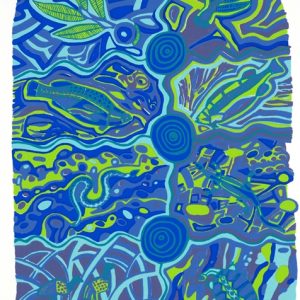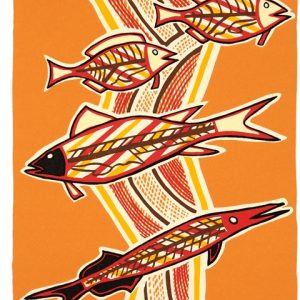Description
Details
- Medium: Etching
- Size: 465 x 250 (image) and 610 x 330 (paper)
- Paper: Magnani Incisioni 300gsm
- Edition: 45
- Published: Brisbane, December 2005
- Studio: Queensland College of Art, Brisbane,QLD
- Printer: David Jones
Subject
Gima Guun is a traditional hunting word. It is associated with the hunting dogs for pig hunting. We go pig hunting regularly on the island. When we go hunting sometimes we go with 8 to 10 dogs because some of the pigs are really big. There are big boars with tusks. The inspiration for the work came from my thinking about the patience you must have for this type of hunting. You can stand for hours up until the dogs start running around. You can see that they are smelling the pig, and in this artwork you’re standing there. The dogs are running around you and they can’t pick up the smell. They can smell it but there are pig tracks from yesterday and last week. The dogs are getting confused air. When one out of those eight dogs – he will run – he will smell the pig that’s near us. When he runs he smells it and he’s going to find the pig before all the other dogs. Then all the dogs are going to run up to him, then we run after the pig. The work is about just that part of the hunting. Just that hunting – we say in language that this dog, it had Gima Guun – the smell of the pig. Some of the dogs, they just smell the feet but this one is quite popular this smelling up in the air. His nose will point up like that. He will hop almost like a wallaby or kangaroo running and then he’ll find the pig. We’ve got small dogs. Our dogs weren’t big. The dog is a totem on our island and it’s part of my group. They’ve originally migrated from New Guinea and they are little, this size dog, very small. Their colour is brown/black and they look like dingoes but they’re not dingoes. They’ve got very small noses – about the same size as the dingo. We call it Umai – he’s a totem of the island.
Dennis Nona Biography
Born in 1973 on Badu Island in the Torres Strait
Dennis Nona was taught the traditional craft of woodcarving when he was still a young boy. This skill has been developed and translated into the incredibly intricate and beautiful linocuts, etchings and sculptures created by the artist since the commencement of his art practice in 1989. Dennis Nona’s work is inspired by coastal life, family, traditional medicines and the myths and legends of the Torres Strait.
He has vividly documented the ancient myths and legends of his island and the wider Torres Strait that had previously been transmitted by oral story-telling and dance. Dennis Nona uses a highly graphic way of storytelling, and links the works with a matrix of delicately lined clan patterning, that binds the entire story to its place of origin.
Dennis holds a Degree in Visual Arts from Cairns TAFE and a Diploma in Visual Arts in Print Making from the Australian National University in Canberra. His art has been collected by a number of prestigious collections and art galleries worldwide, with the number now exceeding 46. He has exhibited his art on more that 160 occasions in some of the most prestigious galleries in the world.
Dennis has won the Telstra National Aboriginal and Torres Strait Islander Art Ward for Works on Paper on three occasions and was an outright winner for a sculpture. He has also won numerous other art awards for his prints.
Initially excelling in lino cuts, Dennis expanded into etchings which have become some of the finest examples of Australian First Nations art.








